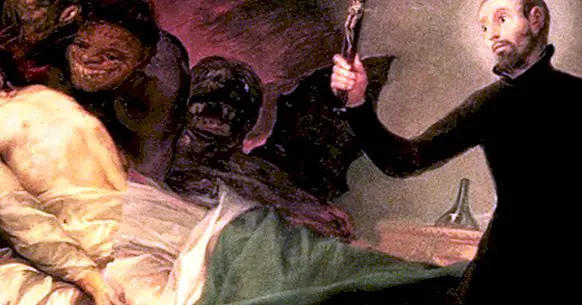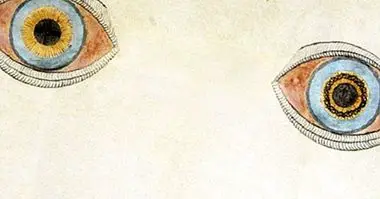History of psychotherapy and clinical psychology
What we currently understand as psychotherapy has existed since the beginning of time, although it has not always had the same form. However, the fundamental role of the word and the change of habits as methods to achieve mental health have been recognized by most human societies.
In this article we will describe synthetically the history of psychotherapy and clinical psychology . For this we will make a journey that goes from the Ancient Age to the appearance of cognitive-behavioral therapy, the predominant model today.
- Related article: "Types of psychological therapies"
Psychotherapy throughout the times
In ancient times our ancestors attributed the unexplainable phenomena to the action of supernatural forces such as gods, demons and spirits. Psychic life and mental disorders were no exception.
The Egyptians saw the suggestion as a form of magic that could be used as a complement to medical treatments , and the Greeks believed that physical and mental illnesses depended on the bodily imbalance of four fluids or humors. Similarly, in China, health was understood as the balance between vital forces.
It is believed that the first psychotherapies emerged in the Islamic world . Between the 10th and 12th centuries AD, thinkers and doctors like Abu Zayd al-Balkhi, Zakariya al-Razi and Avicenna introduced the concepts of "mental health" and "psychotherapy" and described a large number of neuropsychological alterations.
The appearance of psychotherapy in Europe was delayed until the Renaissance, since in the Middle Ages the yoke of Christianity blocked advances in this field. For many centuries, mental health problems they were linked to demonic influences . In fact, mesmerism and hypnotherapy, practiced by Mesmer, Puységur or Pussin, were some of the first psychological treatments properly European, in the eighteenth century.
Later the influence of rationalist and empiricist philosophers promoted the consolidation of psychology as a social science . The alienists Pinel and Esquirol were decisive in the development of moral treatment, which defended the rights of psychiatric patients against the abuses of religious "therapies".
Psychoanalysis and scientific psychology
Charcot's studies on hysteria and other neuroses, as well as Janet's work on dissociation, influenced the appearance of the psychoanalytic theory of Sigmund Freud , which postulated that human behavior is determined fundamentally by unconscious factors and by the experiences lived in childhood.
At the same time, at the end of the 19th century, Granville Stanley Hall founded the American Psychological Association (or APA) , which today continues to be the main organization of the profession. Clinical psychology also emerged in this period thanks to Witmer's work with children with learning problems at the University of Pennsylvania.
While Freud's disciples, such as Adler, Jung or Horney, expanded and revised the hypotheses of psychoanalysis, scientific psychology was still developing through the foundation of institutions, departments, clinics and publications on psychology. The United States was established as the nucleus of these developments.
The rise of behaviorism
Although psychoanalysis continued to be strong during the first half of the 20th century, Behaviorism became the predominant orientation in this period. The contributions of Thorndike, Watson, Pávlov and Skinner made observable behavior the focus of psychological analysis and promoted the development of brief behavioral therapies.
Skinner himself devised a number of techniques based on operant conditioning, mainly reinforcement. Wolpe created systematic desensitization, the antecedent of modern exposure therapy, while Eysenck compiled the available evidence on the lack of efficacy of psychoanalysis as a treatment.
Behaviorism was key in the evolution of psychotherapy, but in the 40s and 50s there appeared different perspectives that reacted to behavioral reductionism , which minimized the relevance of thought, emotion and will.
Existentialism, humanism and systemic therapy
The existential psychotherapies of Viktor Frankl, Otto Rank or R. D. Laing arose from psychoanalysis.The same happened with the client-centered therapy of Rogers, which managed to focus the psychotherapeutic interest on the existence of factors common to the different orientations that explain the effectiveness of the therapy.
Carl Rogers and Abraham Maslow were the two pioneers of humanistic psychology. These authors thought that the human being has a natural tendency towards self-realization and personal growth , and defended psychotherapy as a method to help clients develop as people, based on their values. In this humanistic current is also the Gestalt therapy, created by Fritz Perls and Laura Perls in the middle of the century, although it appeared something before Rogers and Maslow developed their ideas.
Later, in the 1960s and 1970s, authors such as Wilhelm Reich and Alexander Lowen popularized body psychotherapies, which claimed the body as the center of human experience. However, their theories were dismissed by the scientific community for its lack of empirical solidity.
Systemic and family therapies they appeared from the 70s with the popularization of the General Systems Theory and the contributions of the Milan School, the Structural School and the Mental Research Institute of Palo Alto. While existentialism and humanism were diluted, systemic therapy was consolidated during the following years.
Cognitivism: return to mind
The cognitive orientation was preceded by George Kelly, who argued that people understand the world through idiosyncratic psychological constructs. However, the inflection point was assumed the therapies of Ellis and Beck, emerged in the 50s and 60s .
Albert Ellis' Rational Emotional Behavioral Therapy (REBT) focused on the technique that would later be known as "cognitive restructuring". For his part, Aaron Beck developed Cognitive Therapy for depression, a highly structured and systematized procedure that served as a model to many other similar therapies.
Although cognitivist therapies emerged independently, in many cases at the hands of authors trained in the psychoanalytic tradition , the truth is that behaviorism and scientific psychology also had a great influence on them. These complementary models ended up converging in cognitive-behavioral therapies.
Recent therapeutic developments
At least since the 80s and 90s of the last century the focus of psychotherapy has been the demonstration of the efficacy of treatments for specific disorders and problems. In this, the American Psychological Association, with a predominantly cognitive-behavioral orientation, has had a great influence.
The turn of the century has also brought a boom of therapeutic eclecticism . Although cognitive-behavioral therapy has been consolidated as a framework for global action, a large number of professionals and interventions have popularized the use of techniques from varied orientations to compensate for the limitations of cognitive-behavioral therapy.
In particular, the importance of emotions and language has been claimed. The combination of the cognitive-behavioral model with the theory of relational frames and with mindfulness meditation, among other techniques, has promoted the emergence of third-generation therapies , which currently solidify as the future of psychotherapy.
- Related article: "What are third-generation therapies?"



















